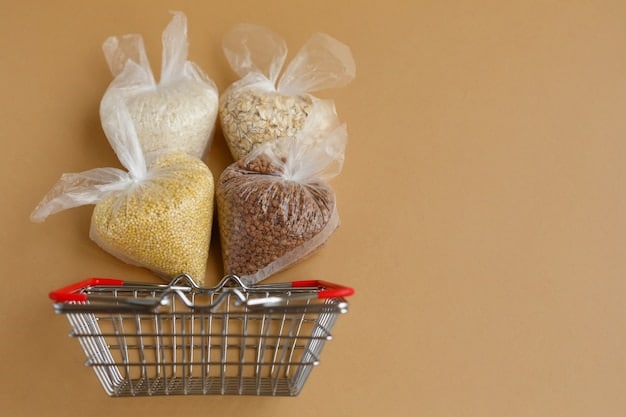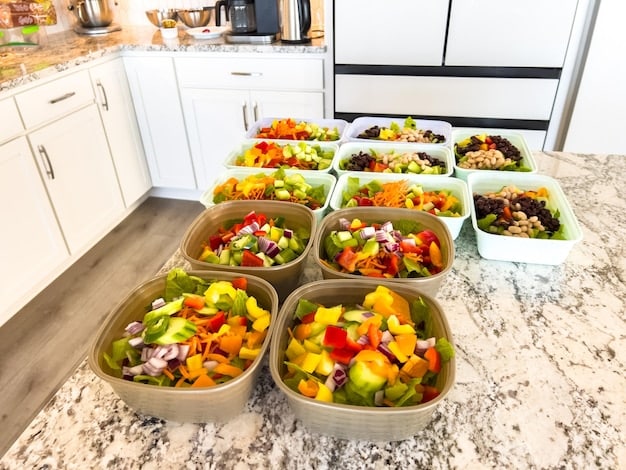Master Budget Meal Planning: Save $200+ Monthly Guide

This guide provides a comprehensive framework for mastering budget meal planning, offering practical strategies and actionable tips to significantly reduce food expenditures by $200 or more each month without compromising nutrition or taste.
Are you feeling the pinch of rising grocery costs? Wondering how to feed yourself or your family nutritious, delicious meals without breaking the bank? This in-depth guide on The Ultimate Guide to Meal Planning on a Budget: Save $200+ Per Month offers actionable strategies designed to transform your mealtime habits and significantly reduce your food expenses.
Understanding the Basics of Budget Meal Planning
Embarking on a journey to save money on groceries doesn’t mean sacrificing quality or flavor. It’s about being strategic, informed, and proactive. The core principle of budget meal planning revolves around making intentional choices before you even step foot in a grocery store.
Many consumers underestimate just how much their spontaneous shopping trips and lack of a coherent plan contribute to overspending. Without a clear direction, it’s easy to succumb to impulse buys, unnecessary convenience foods, and expensive brand names. This section lays the groundwork for how a structured approach to your meals can yield substantial financial savings.
Why Meal Planning is Your Financial Ally
Meal planning isn’t merely a culinary exercise; it’s a powerful financial tool. By deciding what you’ll eat in advance, you minimize food waste, optimize your grocery list, and avoid last-minute, often costly, takeout decisions.
- Reduced Food Waste: Planning ensures you buy only what you need and use it before it spoils, saving money on discarded food.
- Controlled Spending: A strict list based on your meal plan keeps you from impulse purchases at the supermarket.
- Time Efficiency: Knowing what to cook saves time on daily decision-making and potentially reduces cooking frequency through batch cooking.
Setting Realistic Savings Goals
While the goal of saving $200+ per month might seem ambitious, it is entirely achievable with consistent effort and smart strategies. Start by tracking your current food spending for a month. This baseline will reveal exactly where your money is going and highlight areas for improvement. This understanding fuels motivation and helps you make targeted adjustments rather than broad, undefined cuts.
Consider dedicating a specific amount to groceries each week or month. This budget acts as a boundary, encouraging creativity and resourcefulness in your meal choices. Remember, small, consistent changes accumulate into significant savings over time. It’s about building sustainable habits, not just short-term fixes.
Strategic Grocery Shopping: Your First Line of Defense
The supermarket can be a minefield for budget-conscious shoppers. Without a well-thought-out plan, it’s easy to fall prey to marketing tactics and convenience traps. Strategic grocery shopping is about maximizing value, minimizing waste, and ensuring every item in your cart serves a purpose within your meal plan.
Developing effective grocery shopping habits is paramount to achieving significant savings. This includes everything from when you shop to how you navigate the aisles and what items you prioritize.
Mastering the Grocery List
Your grocery list is your ultimate defense against overspending. It should be meticulously crafted, based entirely on your pre-planned meals and what you already have at home. Before writing your list, always check your pantry, fridge, and freezer to avoid buying duplicates.
- Categorize Items: Grouping items by section (produce, dairy, pantry) saves time and helps you stick to your list.
- Prioritize Needs: Distinguish between essential ingredients and optional items to avoid unnecessary purchases.
- Stick to the List: Once at the store, make a firm commitment to buy only what’s on your list.
Consider using digital grocery list apps that allow you to easily add items as you run out or as you plan your meals. Many apps also offer features like price comparisons or store-specific deals, further aiding your savings efforts.

Shopping Smart: Discounts and Bulk Buys
The timing and method of your shopping can dramatically impact your bill. Sundays and Mondays often see fresh weekly sales. Always check store flyers and online circulars for deals before you shop. Loyalty programs can also offer significant discounts and personalized coupons based on your purchasing history.
Buying in bulk can lead to substantial savings, especially for non-perishable items like dried beans, rice, pasta, and frozen vegetables. However, only buy in bulk if you have the space to store it and are confident you will use it before it expires. Spoiled bulk purchases negate any potential savings.
Compare unit prices whenever possible. A larger package might seem cheaper, but on a per-ounce or per-unit basis, a smaller package could sometimes offer better value. This simple check ensures you’re always getting the most for your money.
Pantry Power: Maximizing Your Existing Resources
Your pantry, fridge, and freezer are often untapped reservoirs of potential meals and savings. Before planning new meals or heading to the store, conduct a thorough inventory of what you already possess. This step prevents redundant purchases and encourages creative use of ingredients that might otherwise go to waste.
A well-stocked, organized pantry is a cornerstone of effective budget meal planning. It allows for flexibility, reduces last-minute dashes to the store, and enables you to build meals around core, affordable ingredients.
The Art of Inventory and Rotation
Regularly taking stock of your ingredients is crucial. Knowing what you have on hand helps you plan meals that utilize existing items, thus reducing your grocery list and preventing food from expiring unused. Implement a “first-in, first-out” system for perishable goods, ensuring older items are consumed before newer ones.
Organize your pantry, fridge, and freezer in a way that makes items visible and accessible. Group similar items together and store staples in clearly labeled containers. This organization not only saves time but also makes it easier to spot what you need and what’s running low.
Staples for Savings: Essential Pantry Items
Building a robust pantry of versatile, budget-friendly staples is key. These items form the foundation of countless meals, allowing you to create diverse dishes with minimal fresh additions. Examples include:
- Grains: Rice (brown, white), pasta, oats, quinoa.
- Legumes: Dried or canned beans (black, kidney, chickpeas), lentils.
- Canned Goods: Diced tomatoes, tomato paste, tuna, salmon, various vegetables.
- Spices and Herbs: A well-stocked spice rack can transform simple ingredients into flavorful meals, reducing reliance on expensive pre-made sauces.
Focus on buying these staples when they are on sale. Over time, this consistent stocking up creates a resilient pantry that dampens the impact of fluctuating prices on fresh produce and proteins.
Creative Cooking: Recipes Designed for Your Wallet
Budget meal planning thrives on creativity in the kitchen. This isn’t about bland, repetitive meals but rather about transforming affordable ingredients into diverse and delicious dishes. The key is to prioritize ingredients that offer high nutritional value and versatility at a low cost.
Moving away from reliance on expensive cuts of meat and exotic produce can open up a world of budget-friendly culinary possibilities. This section delves into strategies for crafting meals that are both economical and satisfying.
Embracing Plant-Based Proteins
Meat and poultry are often the most expensive components of a meal. Incorporating more plant-based proteins can significantly cut your grocery bill while also offering numerous health benefits. Think of dishes centered around:
- Lentils: Excellent in soups, stews, curries, or as a meat substitute in tacos or burgers.
- Beans: Black beans, chickpeas, kidney beans are incredibly versatile for chilis, salads, wraps, and casseroles.
- Tofu and Tempeh: Absorbs flavors well and can be stir-fried, baked, or grilled.
These ingredients are not only cheaper but also shelf-stable (if dried or canned), making them perfect for stocking up when on sale. Experiment with different spices and cooking methods to prevent monotony.
Smart Use of Produce and Leftovers
Fresh produce can get expensive quickly. Focus on seasonal fruits and vegetables, which are typically cheaper and at their peak flavor. Frozen vegetables are also an excellent budget-friendly option, retaining much of their nutritional value and preventing spoilage.
Another crucial aspect of creative cooking is learning how to repurpose leftovers. Instead of simply reheating, think about how components of one meal can be transformed into another. Leftover roasted chicken can become chicken salad sandwiches or a topping for a quick pizza. Cooked rice can turn into fried rice or a base for a grain bowl. This approach significantly reduces food waste and extends your meal possibilities.
Advanced Strategies for Maximum Savings
Once you’ve mastered the basics of meal planning, strategic shopping, and creative cooking, it’s time to explore advanced techniques that can push your savings even further. These strategies require a bit more planning and effort but offer substantial financial rewards.
From becoming a proficient batch cooker to understanding the nuances of food preservation, these methods elevate your budget meal planning game and ensure you maximize every dollar spent on groceries.
Batch Cooking and Meal Prep Like a Pro
Batch cooking involves preparing larger quantities of food at one time, usually on a designated “prep day,” and then portioning it out for meals throughout the week. This saves time during busy weekdays and ensures you always have healthy, homemade options readily available, deterring expensive takeout.
Consider preparing components of meals, such as cooking a large batch of grains, chopping vegetables, or preparing a versatile protein like shredded chicken or ground beef. These components can then be assembled into different meals quickly.

Freezing Frugally: Preserving Your Purchases
Your freezer is a powerful tool for savings. Learn what foods freeze well and how to properly store them to extend their shelf life. This is particularly useful for bulk purchases, sale items, and leftover cooked meals.
- Categorize and Label: Clearly label everything with the item and date it was frozen.
- Portion Control: Freeze items in individual or meal-sized portions for easy thawing and use.
- Blanching Vegetables: For fresh vegetables, blanching them before freezing helps retain their texture and nutrients.
Don’t overlook the potential of freezing ingredients like herbs (chopped with oil in ice cube trays), broths, overripe fruit for smoothies, and even bread when bought on sale. This proactive preservation prevents food waste and ensures you have ingredients ready when needed.
Troubleshooting Common Budget Meal Planning Hurdles
Even with the best intentions, budget meal planning can present challenges. Life happens – unexpected events, busy schedules, and even plain old cooking fatigue can derail your efforts. Recognizing these common pitfalls and having strategies to overcome them is crucial for long-term success.
This section addresses common obstacles and offers practical solutions, helping you stay on track with your budgeting goals even when things get tough.
Dealing with Food Fatigue and Lack of Inspiration
Eating the same meals repeatedly, even if they are budget-friendly, can lead to “food fatigue.” This is often a precursor to abandoning your meal plan for more exciting (and expensive) alternatives. To combat this:
- Rotate Recipes: Build a repertoire of 20-30 diverse, budget-friendly recipes and rotate them.
- Experiment with Spices: A simple change in seasoning can transform a familiar dish.
- Explore New Cuisines: Many international cuisines are inherently budget-friendly and offer a wealth of new flavors.
Seek inspiration from online resources, cookbooks, or even budget food blogs. Remember that variety doesn’t necessarily mean expensive or complicated ingredients; it can often be achieved through versatile staples and creative combinations.
Managing Unexpected Events and Busy Schedules
Life is unpredictable, and sometimes, even the most meticulously planned schedule can go awry. Instead of throwing in the towel, have contingency plans in place:
- Emergency Meals: Keep a few quick, pantry-based meals on hand for days when cooking from scratch isn’t feasible (e.g., pasta with canned sauce, lentil soup, quick quesadillas).
- Utilize Your Freezer: Rely on your stash of pre-cooked, frozen meals for those particularly hectic evenings.
- Flexibility: If you miss a meal on your plan, don’t feel guilty. Adjust the rest of the week’s plan accordingly rather than abandoning it entirely. The goal is progress, not perfection.
Remember that even small efforts contribute to your overall savings. A single planned meal can prevent an expensive takeout order, making a difference over time.
Sustaining Your Savings: Long-Term Habits for Financial Health
Achieving significant savings on your food budget isn’t a one-time event; it’s a journey that requires consistent application of good habits. The real victory lies in making budget meal planning an ingrained part of your lifestyle, ensuring sustained financial benefits for years to come.
This final section focuses on the long-term perspective, emphasizing how small, continuous efforts lead to substantial cumulative savings and a healthier financial outlook.
Regular Review and Adjustment
Your life, finances, and even tastes will evolve. What works for your budget meal plan today might need tweaking six months from now. Make it a habit to regularly review your spending, savings, and meal planning process.
- Monthly Financial Check-ins: Assess your food budget performance and identify areas for improvement.
- Recipe Rotation Refresh: Periodically update your recipe repertoire to keep things fresh and prevent boredom.
- Seasonal Adjustments: Align your meal plans with seasonal produce availability to maximize savings and flavor.
This iterative process ensures your meal planning strategy remains effective, relevant, and enjoyable. It prevents stagnation and allows you to adapt to changing circumstances.
Beyond Food: The Ripple Effect of Smart Budgeting
The benefits of budget meal planning extend far beyond saving money on groceries. The discipline and organizational skills developed through this process often spill over into other areas of your financial life. You become more mindful of spending, more adept at planning, and more resourceful in general.
The accumulated savings can be allocated towards other financial goals, whether it’s building an emergency fund, paying down debt, or saving for a significant purchase. This holistic view reinforces the value of consistent, small changes leading to substantial long-term financial health.
Embrace the journey of budget meal planning not just as a way to save money, but as a path to greater financial control, reduced stress, and increased confidence in managing your household resources. The $200+ per month you save is just the beginning.
| Key Area | Brief Strategy |
|---|---|
| planification | Plan meals for the week based on what you have and sales. |
| list | Create a detailed grocery list and stick to it strictly. |
| Prep | Batch cook and prepare ingredients ahead of time. |
| waste | Utilize leftovers and proper food storage to minimize waste. |
Frequently Asked Questions About Budget Meal Planning
▼
Saving $200+ per month is highly realistic for many households, especially those currently spending above average on food. It requires consistent effort in meal planning, strategic shopping, and reducing food waste. Families tend to see the most significant savings. Individual results vary based on current spending habits, household size, and dedication to the strategies outlined.
▼
Excellent budget-friendly staples include dried or canned beans and lentils, rice, pasta, oats, and seasonal fresh produce. Other cost-effective items are frozen vegetables, canned tomatoes, eggs, and versatile meats like chicken thighs or ground turkey when on sale. A well-stocked spice rack is also crucial for transforming simple ingredients into flavorful meals.
▼
To simplify meal planning for busy schedules, focus on batch cooking components rather than full meals. Cook a large quantity of grains, chop vegetables, or pre-cook proteins on a designated prep day. Utilize simple recipes requiring minimal ingredients and cooking time. Also, keep a few “emergency” pantry meals for days when cooking from scratch is impossible, like pasta with canned sauce.
▼
Absolutely. Eating healthy on a budget is very achievable. Focus on whole, unprocessed foods like dried beans, lentils, grains, seasonal fruits and vegetables, and affordable protein sources. Avoid expensive convenience foods and sugary drinks. Preparing meals from scratch using these basic ingredients is often healthier and more nutritious than relying on pre-made or restaurant meals.
▼
The biggest mistake is often inconsistency or lack of a clear plan. Going to the grocery store without a list, buying impulsively, or not using ingredients before they spoil are common pitfalls. Another significant error is focusing solely on cutting costs without considering food waste, which can negate any savings. A comprehensive, consistent approach is key to long-term success.
Conclusion
Implementing effective budget meal planning is more than just a momentary financial adjustment; it’s an investment in your financial future and a step towards a more organized, less wasteful lifestyle. By systematically planning your meals, shopping strategically, maximizing your existing pantry, and creatively utilizing ingredients, you can significantly reduce your food expenditure by $200 or more each month. This guide has provided a comprehensive roadmap, equipping you with the knowledge and actionable strategies necessary to achieve substantial savings without sacrificing the quality or enjoyment of your meals. The journey requires commitment and adaptability, but the financial freedom and peace of mind gained are invaluable rewards.





